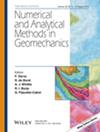循环热荷载作用下低塑性软粘土中能量微桩热-水-力学行为的数值研究
IF 3.4
2区 工程技术
Q2 ENGINEERING, GEOLOGICAL
International Journal for Numerical and Analytical Methods in Geomechanics
Pub Date : 2025-05-23
DOI:10.1002/nag.4007
引用次数: 0
摘要
采用热-水-力耦合非线性有限元模拟研究了能量微桩在热载荷循环作用下的行为。本文分析了两类问题:一类是孤立微桩,与以往的中型孤立能量桩研究进行了比较;另一类是大群微桩,目的是研究相互作用的影响。在这两个问题中,微桩都被认为安装在一层非常柔软的饱和粘土中,其特征是各向同性或各向异性的水力导率。采用现有的两个先进的欠塑性模型,其中一个模型考虑了热软化特征,来描述这两个问题中的粘土行为。在恒定的机械载荷作用下,微桩头沉降在热循环过程中逐渐增大,表现为棘轮效应。对于微桩群,随着微桩间距的减小,沉降增加速度更快。微桩-土界面处产生的超孔隙水压力对土-微桩体系的变形和位移场有重要影响,特别是在微桩群的情况下,影响微桩-土界面处产生的抗剪强度。当水导率为各向异性时,固结过程更快,这意味着在这种情况下,超孔隙水压力的发展减少。随着微桩间距的增大,即热相互作用的减小,群内微桩在一个周期内的换热通量接近于孤立微桩在同一周期内的换热通量。本文章由计算机程序翻译,如有差异,请以英文原文为准。
Numerical Study on the Thermo‐Hydro‐Mechanical Behavior of Energy Micropiles in Hypoplastic Soft Clay Under Cyclic Thermal Loading
Coupled nonlinear thermo‐hydro‐mechanical finite element simulations were carried out to investigate the behavior of energy micropiles subjected to thermal loading cycles. Two kinds of problems were analyzed: The case of an isolated micropile, for which comparison with previous research on medium‐size isolated energy pile is provided, and the case of large groups of micropiles, with the aim of investigating the interaction effects. In both problems, micropiles were considered installed in a thick layer of very soft, saturated clay, characterized by isotropic or anisotropic hydraulic conductivity. Two advanced existing hypoplastic models, one incorporating the thermal softening feature, were used to describe the clay behavior in both problems. The settlements of the micropile head were found to increase during thermal cycles under constant mechanical load, showing a sort of ratcheting. For micropile groups, the settlement increase rate was faster as the spacing between micropiles was reduced. The excess pore water pressures developed at the micropile‐soil interface played a significant role on the deformation and displacement fields of the soil‐micropile systems, especially in the case of micropile groups, affecting the shear strength developed at the micropile‐soil interface. The consolidation process was faster when the hydraulic conductivity was anisotropic, meaning that the development of excess pore water pressure was reduced in this case. As the spacing between the micropiles increased, i.e., as thermal interaction decreased, the heat flux exchanged by a micropile of the group during one cycle approached the heat flux exchanged by an isolated micropile in the same period.
求助全文
通过发布文献求助,成功后即可免费获取论文全文。
去求助
来源期刊
CiteScore
6.40
自引率
12.50%
发文量
160
审稿时长
9 months
期刊介绍:
The journal welcomes manuscripts that substantially contribute to the understanding of the complex mechanical behaviour of geomaterials (soils, rocks, concrete, ice, snow, and powders), through innovative experimental techniques, and/or through the development of novel numerical or hybrid experimental/numerical modelling concepts in geomechanics. Topics of interest include instabilities and localization, interface and surface phenomena, fracture and failure, multi-physics and other time-dependent phenomena, micromechanics and multi-scale methods, and inverse analysis and stochastic methods. Papers related to energy and environmental issues are particularly welcome. The illustration of the proposed methods and techniques to engineering problems is encouraged. However, manuscripts dealing with applications of existing methods, or proposing incremental improvements to existing methods – in particular marginal extensions of existing analytical solutions or numerical methods – will not be considered for review.

 求助内容:
求助内容: 应助结果提醒方式:
应助结果提醒方式:


